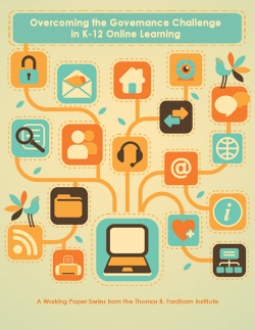Online learning and our current system of local education governance are at odds with one another, to say the least. In this paper, John Chubb examines how local school district control retards the widespread use of instructional technologies. He argues that the surest way to break down the system’s inherent resistance to technology is to shift control from the local district—and thus the school board—and put it in the hands of states. He then outlines ten steps to get us to this brave new governance system:
- Set K-12 Online-Learning Policy at the State Level
- Create a Public Market for K-12 Online Learning
- Provide Students the Right to Choose Online Learning Full Time
- Provide Students the Right to Choose Online Learning Part Time
- Authorize Statewide Online Charter Schools, Overseen by Statewide Charter Authorizers
- License Supplementary Online Providers
- Fund All Learning Opportunities Equally Per Pupil
- Exempt Online and Blended Teaching from Traditional Teacher Requirements Including Certification and Class Size
- Establish Student Learning as the Foundation of Accountability for Online Schools and Providers
- Address Market Imperfections by Providing Abundant Information to Students, Families, Schools, and Districts
Download the paper to learn more, and be sure to read Fordham’s other papers on this vital topic.
This is the fifth and final paper in a series examining sound digital-learning policy. Previous papers appearing in this series include “Quality Control in K-12 Digital Learning: Three (Imperfect) Approaches” by Frederick M. Hess; “Teachers in the Age of Digital Instruction” by Bryan C. Hassel and Emily Ayscue Hassel; “School Finance in the Digital-Learning Era” by Paul T. Hill; and “The Costs of Online Learning” by Tamara Butler Battaglino, Matt Haldeman, and Eleanor Laurans. This working paper series is generously supported by the Charles and Helen Schwab Foundation.




